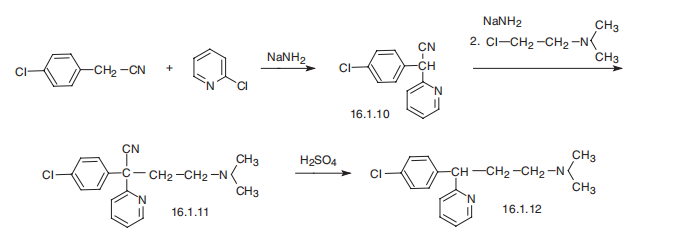|
| | Chlorpheniramine Basic information |
| Product Name: | Chlorpheniramine | | Synonyms: | dl-Chlorpheniramine;CHLORPHENIRAMINE;Dexchlorpheniramine Impurity 8 | | CAS: | 78539-96-5 | | MF: | C16H19ClN2 | | MW: | 274.79 | | EINECS: | | | Product Categories: | | | Mol File: | Mol File |  |
| | Chlorpheniramine Chemical Properties |
| pka | pKa 9.16±0.02(H2O
t = 25
c = 0.002 to 0.01) (Uncertain) |
| | Chlorpheniramine Usage And Synthesis |
| Description | Chlorpheniramine is an antihistamine. Antihistamines are medications used to relieve symptoms of allergies, hay fever (allergic rhinitis), and the common cold. These symptoms include sneezing, runny nose, watery eyes, and itchy throat. Chlorpheniramine is sold under different brand names, including Chlor-Trimeton®. | | Uses | Chlorpheniramine reduces the allergic response of the organism caused by histamine. It is
used for allergy symptoms, rhinitis, and also as an ingredient in numerous compositions
with ephedrine and pseudoephedrine, which are recommended for colds, upper respiratory tract infections, and allergic rhinitis. Synonyms of this drug are chlortrimeton, histaspan,
tripolon, and teldrin. | | Definition | Chlorphenamine is a tertiary amino compound that is propylamine which is substituted at position 3 by a pyridin-2-yl group and a p-chlorophenyl group and in which the hydrogens attached to the nitrogen are replaced by methyl groups. A histamine H1 antagonist, it is used to relieve the symptoms of hay fever, rhinitis, urticaria, and asthma. It has a role as a H1-receptor antagonist, an antipruritic drug, a histamine antagonist, a serotonin uptake inhibitor, an antidepressant and an anti-allergic agent. It is a tertiary amino compound, a member of monochlorobenzenes and a member of pyridines. | | Side effects | Side effects that you should report to your doctor or health care professional as soon as possible:
allergic reactions like skin rash, itching or hives, swelling of the face, lips, or tongue
breathing problems
changes in vision
confused, agitated, nervous
fast, irregular heartbeat
feeling faint, dizzy
seizures
tremor
trouble passing urine or change in the amount of urine
unusual sweating
unusually weak or tired
Side effects that usually do not require medical attention (report to your doctor or health care professional if they continue or are bothersome):
constipation or diarrhea
drowsy
dry mouth, nose, throat
headache
loss of appetite
stomach upset, vomiting
trouble sleeping | | Synthesis | Chlorpheniramine, 3-(p-chlorophenyl)-3-(2-pyridyl)propyldimethylamine
(16.1.12), is synthesized in two ways. The first is from 4-chlorbenzylcyanide, which
is reacted with 2-chlorpyridine in the presence of sodium amide to form 4-chlorphenyl
(2-pyridyl)acetonitrile (16.1.10). Alkylating this with 2-dimethylaminoethylchloride in the
presence of sodium amide gives |?-(4-chlorphenyl)-|?-cyano-N,N-dimethyl-2-pyridinepropanamine
(16.1.11), the hydrolysis and decarboxylation of which lead to chlorpheniramine
(16.1.12).
The second way is from pyridine, which undergoes alkylation by 4-chlorobenzylchloride,
giving 2-(4-chlorobenzyl)pyridine (16.1.13). Alkylating this with 2-dimethylaminoethylchloride
in the presence of sodium amide gives chlorpheniramine (16.1.12).
|
| | Chlorpheniramine Preparation Products And Raw materials |
|